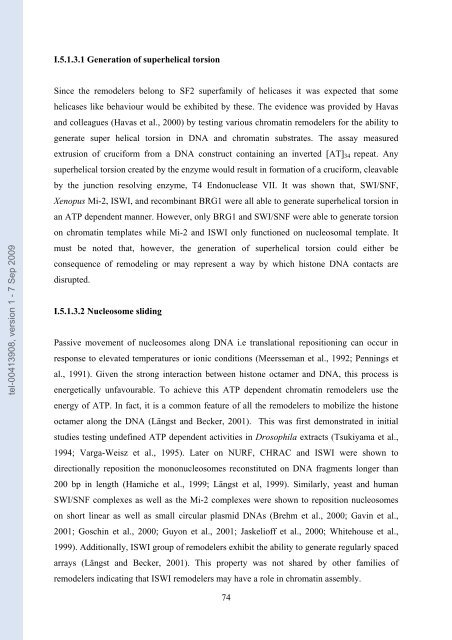Etudes sur le mécanisme de remodelage des nucléosomes par ...
Etudes sur le mécanisme de remodelage des nucléosomes par ...
Etudes sur le mécanisme de remodelage des nucléosomes par ...
You also want an ePaper? Increase the reach of your titles
YUMPU automatically turns print PDFs into web optimized ePapers that Google loves.
tel-00413908, version 1 - 7 Sep 2009<br />
I.5.1.3.1 Generation of superhelical torsion<br />
Since the remo<strong>de</strong><strong>le</strong>rs belong to SF2 superfamily of helicases it was expected that some<br />
helicases like behaviour would be exhibited by these. The evi<strong>de</strong>nce was provi<strong>de</strong>d by Havas<br />
and col<strong>le</strong>agues (Havas et al., 2000) by testing various chromatin remo<strong>de</strong><strong>le</strong>rs for the ability to<br />
generate super helical torsion in DNA and chromatin substrates. The assay mea<strong>sur</strong>ed<br />
extrusion of cruciform from a DNA construct containing an inverted [AT]34 repeat. Any<br />
superhelical torsion created by the enzyme would result in formation of a cruciform, c<strong>le</strong>avab<strong>le</strong><br />
by the junction resolving enzyme, T4 Endonuc<strong>le</strong>ase VII. It was shown that, SWI/SNF,<br />
Xenopus Mi-2, ISWI, and recombinant BRG1 were all ab<strong>le</strong> to generate superhelical torsion in<br />
an ATP <strong>de</strong>pen<strong>de</strong>nt manner. However, only BRG1 and SWI/SNF were ab<strong>le</strong> to generate torsion<br />
on chromatin templates whi<strong>le</strong> Mi-2 and ISWI only functioned on nuc<strong>le</strong>osomal template. It<br />
must be noted that, however, the generation of superhelical torsion could either be<br />
consequence of remo<strong>de</strong>ling or may represent a way by which histone DNA contacts are<br />
disrupted.<br />
I.5.1.3.2 Nuc<strong>le</strong>osome sliding<br />
Passive movement of nuc<strong>le</strong>osomes along DNA i.e translational repositioning can occur in<br />
response to e<strong>le</strong>vated temperatures or ionic conditions (Meersseman et al., 1992; Pennings et<br />
al., 1991). Given the strong interaction between histone octamer and DNA, this process is<br />
energetically unfavourab<strong>le</strong>. To achieve this ATP <strong>de</strong>pen<strong>de</strong>nt chromatin remo<strong>de</strong><strong>le</strong>rs use the<br />
energy of ATP. In fact, it is a common feature of all the remo<strong>de</strong><strong>le</strong>rs to mobilize the histone<br />
octamer along the DNA (Längst and Becker, 2001). This was first <strong>de</strong>monstrated in initial<br />
studies testing un<strong>de</strong>fined ATP <strong>de</strong>pen<strong>de</strong>nt activities in Drosophila extracts (Tsukiyama et al.,<br />
1994; Varga-Weisz et al., 1995). Later on NURF, CHRAC and ISWI were shown to<br />
directionally reposition the mononuc<strong>le</strong>osomes reconstituted on DNA fragments longer than<br />
200 bp in <strong>le</strong>ngth (Hamiche et al., 1999; Längst et al, 1999). Similarly, yeast and human<br />
SWI/SNF comp<strong>le</strong>xes as well as the Mi-2 comp<strong>le</strong>xes were shown to reposition nuc<strong>le</strong>osomes<br />
on short linear as well as small circular plasmid DNAs (Brehm et al., 2000; Gavin et al.,<br />
2001; Goschin et al., 2000; Guyon et al., 2001; Jaskelioff et al., 2000; Whitehouse et al.,<br />
1999). Additionally, ISWI group of remo<strong>de</strong><strong>le</strong>rs exhibit the ability to generate regularly spaced<br />
arrays (Längst and Becker, 2001). This property was not shared by other families of<br />
remo<strong>de</strong><strong>le</strong>rs indicating that ISWI remo<strong>de</strong><strong>le</strong>rs may have a ro<strong>le</strong> in chromatin assembly.<br />
74

















